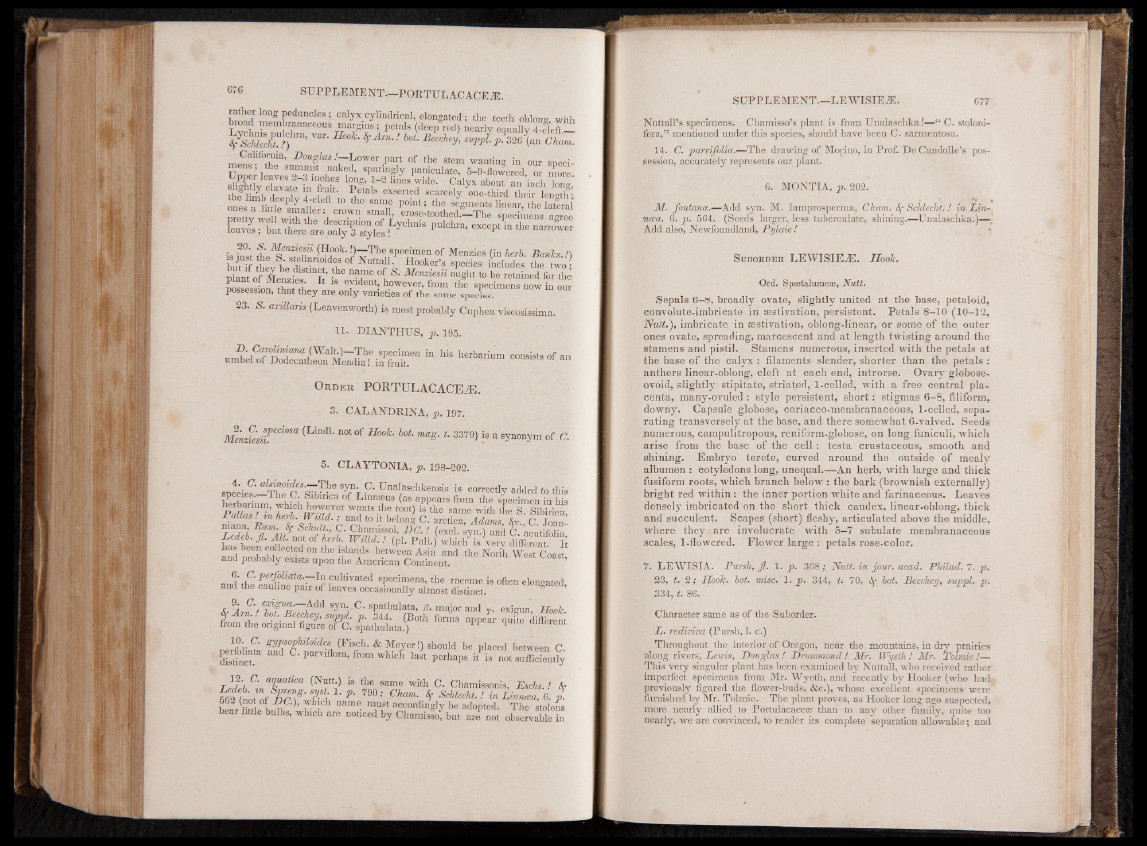
rather long peduncles ; calyx cylindrical, elongated : the teeth „Mono-
broad membranaceous m a ig ij ; petals (deep red) 4 fleft.1-
4-ScAZec/i3r ? )hra’ Var' H k ' S?Arn-! hoU -Beechey, suppl p. 326 (an Cham.
California, Douglas /—Lower part of the stem wanting in our sneci-
mens; the summit naked, sparingly paniculate, 5-9-flowered or more
Upper leaves 2-3 inches long, 1-2 finVwide. Cdyx abom an inch Tong'
thfK^iTtaVaie T T t- Petals exserted scarcely one-third their length-
lmlk deeply 4-cleft to the- same point; the segments linear the lateral
ones a hide smaller: crown small,
• T Menziesii (Hook.!)—The specimen of Menzies (in herb. Banks ')
but R w T T T * °f NuttalL Hooker’s sPecies includes the ^ ;
plant of Menzies T,’ T T T S T I 'S'' Menzlesn p ant ot menzies. it is evident, however, from otuhSeh ts ptoe c«imreentsa innoedw fionr othuer
possession, that they are only varieties of the same species. '
23. S. axillaris (Leavenworth) is most probably Cuphea viscosissima.
11. DIANTHUS, p. 195.
D. Caroliniana(W alt.)—The specimen in his herbarium consists of an umbel o f Dodecatheon Meadia! in fruit. consists ot an
Or d e r PORTULACACE.E.
3. CALANDKINA, p. 197.
Men£'esii.ed0Sa (Lind1' ***. °f H°°h M* + 3379) is a synonym of C.
5. CLAYTONIA, p. 198-202.
s v tc iS—Th? ^ T V C' Una'aschkensis is correctly added to this
® I p l h I - Vu °f Llnn£eus (as appears from the specimen in his
SBa/ lTiaTs . Tm’ rhebrlb7,C. hWr rilaldV.;e r aTndn ttoS i-tth b6e rlooontg> iCs .$ a1rc tsiacma, eA wdaitmh st he& -cS . CS ibTirnicana-,
niana, Bam. 8f Schult., C. Cbamissoi, DC. ! iexcl svn 1 inri p \ v r
T T A' °f hu ri: J ^ ^ d - '■ (pi- PaU-) which is very different.0 Tt
/a s been collected on the islands between Asia and the North West Coast
and probably exists upon the American Continent. \
P^fihata.—Iia cultivated specimens, the raceme is often elongated
and the cauhne pair of leaves occasionally almost distinct. S
A- 9a£ ' i syu- c . spathulata, 0. major and y. exigua, Hook.
Beedhey, suppl. p. 344. (Both forms appear qJte different
from the original figure of C. spathulata.) 1 •
i- T' SyPS0Phil°ides (Fisch. & Meyer!) should be placed between C
distinct!" f Par^ o r a , from whicli lait perhaps iTis not sufficLntry
T} ? ’h Cl ac^ atlca (Nutt-) is the same with C. Chamissonis, Eschs.! Sr
5 6 2 n o tT fn r T T i l 790 S ham■ * Schlecht! in Linntea, M
i i T namf- T f a^ “ « h g ly be adopted. The stolons
bear little bulbs, which are noticed by Chamisso, but are not observable in
Nuttall’s specimens. Chamisso’s plant is from Unalaschka!—“ C. stoloni-
fera,” mentioned under this species, should have been C. sarmentosa.
14. C. parvifolia.—The drawing of Mopino, in Prof. De Candolle’s possession,
accurately represents our plant.
6. MONTIA, p. 202.
M. fontana.—Add syn. M. lamprosperma, Cham. 8f Schlecht. ! in Lin-,
nesa, 6. p. 564. (Seeds larger, less tuberculate, shining.—Unalaschka.)—
Add also, Newfoundland, Pylaie! _ •
S uborder LEWISIEAh Ilo o k .
Ord. SpEetalume®, Nutt.
Sepals 6 -8 , broadly ovate, slightly united at the base, petaloid,
convolute-imbricate in aestivation, persistent. Petals 8—10 (10—12,
Nutt.), imbricate in aestivation, oblong-linear, or some o f the outer
ones ovate, spreading, marcescent and at length twisting around the
stamens and pistil. Stamens numerous, inserted with the petals at
the base o f the calyx : filaments slender, shorter than the petals :
anthers linear-oblong, cleft at each end, introrse. Ovary globose-
ovoid, slightly stipitate, striated, 1-celled, with a free central placenta,
many-ovuled : style persistent, sh o r t: stigmas 6—8, filiform,
downy. Capsule globose, coriaceo-membranaceous, 1-celled, separating
transversely at the base, and there somewhat 6-valved. Seeds
numerous, campulitropous, reniform-globose, on long funiculi, which
arise from the base o f the c e l l : testa crustaceous, smooth and
shining. Embryo terete, curved around the outside o f mealy
albumen : cotyledons long, unequal.—An herb, with large and thick
fusiform roots, w'hich branch below : the bark (brownish externally)
bright red within : the inner portion white and farinaceous. Leaves
densely imbricated on the short thick caudex, linear.oblong, thick
and succulent. Scapes (short) fleshy, articulated above the middle,
where they are involucrate with 5 -7 subulate membranaceous
scales, 1-flowered. Flower large : petals rose-color.
7. LEWISIA. Pursh, fi. 1. p. 3 6 8 ,- Nutt, in jour. acad. Philad. 7. p.
23, t. 2; Hook. hot. misc. 1. p. 344, t. 70, /j- hot. Beechey, suppl. p.
334, t. 86.
Character same as of the Suborder.
L. rediviva (Pursh, 1. c.)
Throughout the interior of Oregon, near the mountains, in dry prairies
along rivers, Lewis, Douglas ! Drummond ! Mr. Wyeth ! Mr. Tolmie !—
This very singular plant has been examined by Nuttall, who received rather
imperfect specimens from Mr. Wyeth, and recently by Hooker (who had
previously figured the flower-buds, &c.), whose excellent specimens were
furnished by Mr. Tolmie. The plant proves, as Hooker long ago suspected,
more nearly allied to Portulacaceae than to any other family, quite too
nearly, we are convinced, to render its complete separation allowable; and